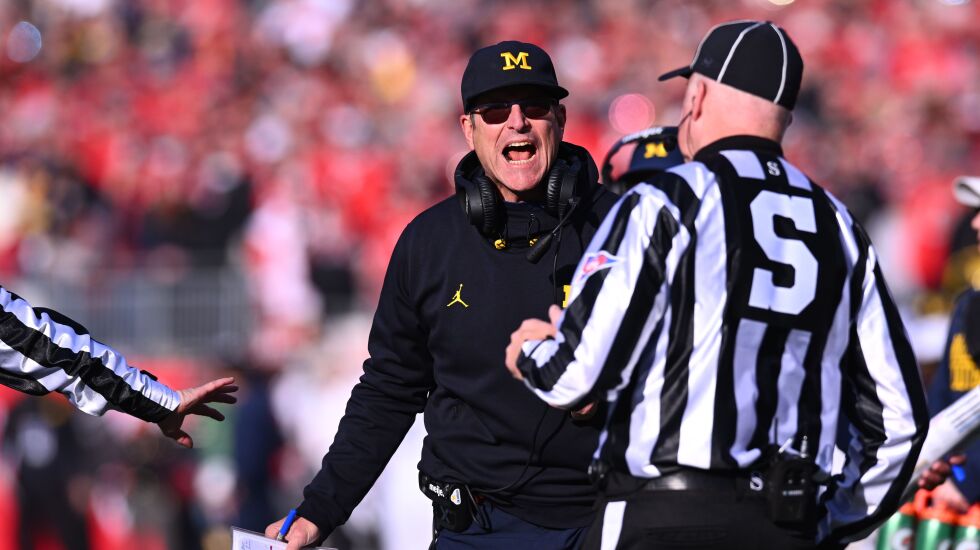
Yep, Michigan walloped Ohio State 45-23 on Saturday, and everybody in Ann Arbor is happy. Michigan coach Jim Harbaugh is really happy.
You would be too, if you picked up $500,000 for the victory, as Harbaugh did. That’s his reward from Michigan for winning the Big Ten East.
But the even more enjoyable part comes this weekend when Michigan takes on Purdue for the Big Ten championship at Lucas Oil Stadium in Indianapolis. Win that game (which the No. 2 Wolverines are almost assured of doing against the unranked 8-4 Boilermakers) and Harbaugh gets another $1 million.
Then he’ll automatically receive another $500,000 because beating Purdue puts Michigan into the College Football Playoff semifinal, and, of course, he gets rewarded for that.
Now, if you’re asking what Wolverine players, meaning those who actually play the game, risk injury, etc., get for this — including stars like quarterback J.J. McCarthy, running back Blake Corum, and linebacker Junior Colson — don’t.
Unless they’ve figured out some way to monetize their name, image, and likeness — the NIL deals players only recently have been allowed to control — they’ll get nothing. This is college football, remember, and these are lads participating in an extracurricular activity, no different from the ballroom dance team or the stand-up comedy club which are available to students at Michigan.
Moreover, if Harbaugh plays his cards — excuse me, players — right this postseason he could end up with a total of $3.275 million extra, according to a study done by USA Today’s Steve Berkowitz. That’s on top of Harbaugh’s $7.05 million base salary. No wonder he says he’s willing to adopt any of his players’ or staff’s unwanted babies, having told ESPN, ‘‘We got a big house. We’ll raise that baby.’’
Nor is Harbaugh alone in the football money rainstorm.
LSU’s Brian Kelly already got $575,000 in bonuses and can get a contract increase of $2.25 million if his Tigers beat Georgia in the SEC championship game. Conversely, Georgia coach Kirby Smart gets $525,000 if the Bulldogs win.
Naturally, the $10 million salary men like Alabama’s Nick Saban, Clemson’s Dabo Swinney and USC’s Lincoln Riley get their extras.
But so too does Boise State’s Andy Avalos who got $25,000 for each of his sixth, seventh, and eighth wins and $25,000 more for winning his school’s six-team division of the Mountain West Conference. Texas San-Antonio’s Jeff Traylor also got the same amount as Avalos for winning his sixth, eighth, ninth, and 10th games.
Central Florida’s Gus Malzahn made $25,000 for both his sixth win and for making it to the American Athletic Conference title game this Saturday. You might remember Malzahn as the former Auburn coach who in 2020 was paid $21.5 million just to go away.
But enough of that.
How does lowly Northwestern fit into this trough feeding? The Wildcats just finished 1-11, last in the 14-team Big Ten Conference, their worst record in 33 years.
Oddly, this came in the same season the school announced its plans for a new, mind-bogglingly expensive $800 million Ryan Field to replace the relatively newly rehabbed ‘‘old’’ Ryan Field. The project, scheduled to be done by 2026, will be funded in large part by, who else?, alum and stadium namesake Pat Ryan.
The odd thing is the stadium will seat only 35,000 people, 12,000 less than current capacity, which is already the smallest capacity in the Big Ten. Consider that the new place will be less than a third of the size of Michigan’s stadium known as the ‘‘Big House.’’ According to Northwestern the goal of the new stadium, is to “create a best-in-the-nation football experience for fans, student-athletes and the community.”
Now don’t feel sorry for Wildcats coach Pat Fitzgerald, who makes $5.4 million annually for his suffering.
But this is pretty strange. Even if the school has a smaller enrollment and far fewer alums than any other Big Ten school, it’s a bit of a head scratcher unless the idea is a full little place is better than a half-empty bigger place.
Maybe Northwestern is banking on TV money being the driver, as well as revenue-sharing from the Big Ten. Maybe it’s counting on the thrill of the boutique experience. But you have to wonder how a place like Michigan feels about this downsizing.
That school could fund 70,000 temporary seats itself every time the Wolverines play in Evanston and likely fill them all with its fans.
And, thus, make even more cash. And keep its coach smiling.







